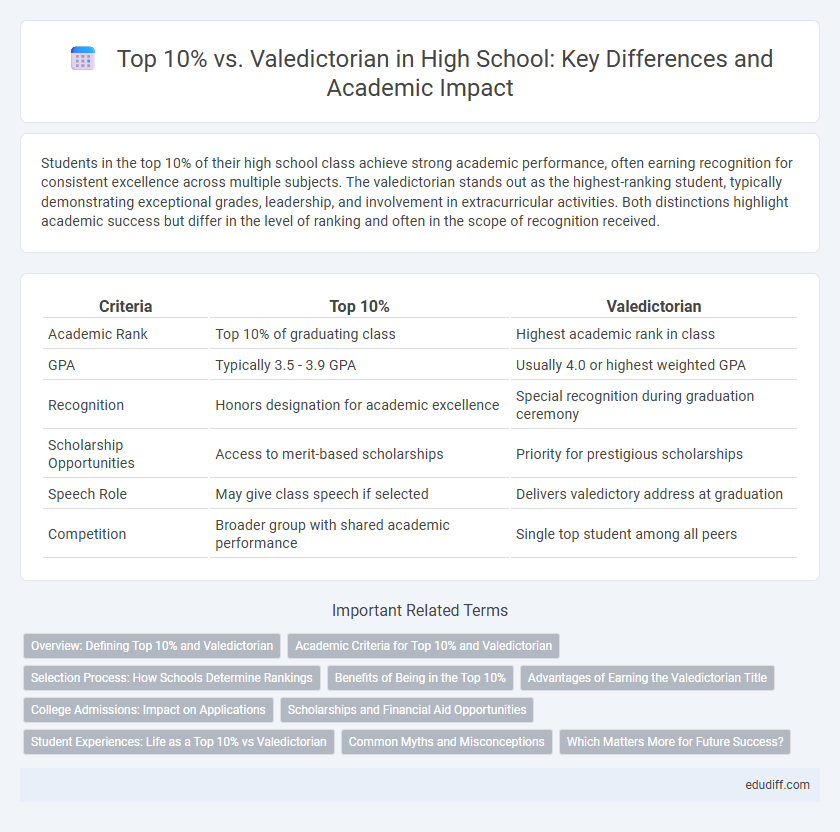Students in the top 10% of their high school class achieve strong academic performance, often earning recognition for consistent excellence across multiple subjects. The valedictorian stands out as the highest-ranking student, typically demonstrating exceptional grades, leadership, and involvement in extracurricular activities. Both distinctions highlight academic success but differ in the level of ranking and often in the scope of recognition received.
Table of Comparison
| Criteria | Top 10% | Valedictorian |
|---|---|---|
| Academic Rank | Top 10% of graduating class | Highest academic rank in class |
| GPA | Typically 3.5 - 3.9 GPA | Usually 4.0 or highest weighted GPA |
| Recognition | Honors designation for academic excellence | Special recognition during graduation ceremony |
| Scholarship Opportunities | Access to merit-based scholarships | Priority for prestigious scholarships |
| Speech Role | May give class speech if selected | Delivers valedictory address at graduation |
| Competition | Broader group with shared academic performance | Single top student among all peers |
Overview: Defining Top 10% and Valedictorian
Top 10% refers to students who rank within the highest ten percent of their graduating class based on GPA or academic performance, highlighting consistent excellence among peers. The Valedictorian is the single student with the highest overall academic achievement in the entire graduating class, often recognized for exceptional grades and leadership. Both distinctions emphasize academic success but differ in scope, with Top 10% representing a broader group and Valedictorian representing the singular top performer.
Academic Criteria for Top 10% and Valedictorian
The Top 10% academic criterion is based on ranking students within their graduating class by GPA, ensuring the highest-performing 10% earn this distinction. The Valedictorian is typically the single student with the highest overall GPA, often considering weighted grades, advanced coursework, and sometimes extracurricular achievements. Academic rigor, including honors, AP, or IB classes, heavily influences both distinctions, with Valedictorian status requiring surpassing peers' cumulative academic performance.
Selection Process: How Schools Determine Rankings
Schools determine academic rankings by carefully analyzing GPA, class rigor, and standardized test scores to identify the top 10% of students, ensuring a broad recognition of high achievers. The valedictorian selection focuses on the single highest overall GPA, often including factors like extracurricular involvement and leadership roles to distinguish the top student. Some schools use weighted GPAs and departmental assessments to refine rankings, creating a precise hierarchy that balances numerical performance and holistic evaluation.
Benefits of Being in the Top 10%
Being in the top 10% of a high school class offers significant advantages such as increased eligibility for a broader range of college scholarships and admissions opportunities compared to a single valedictorian. Students in the top 10% often gain priority consideration for honors programs and special academic recognition, boosting their academic resumes. This status also provides a stronger competitive edge for competitive internships and leadership roles within extracurricular activities.
Advantages of Earning the Valedictorian Title
Earning the valedictorian title signifies the highest academic achievement in a graduating class, often leading to increased scholarship opportunities and enhanced college admission prospects. Valedictorians gain recognition that can boost their resumes and open doors to prestigious internships or leadership programs. This distinction reflects exceptional dedication, discipline, and mastery of coursework beyond the achievements of the top 10% academically.
College Admissions: Impact on Applications
Students ranked in the top 10% of their high school class often receive strong consideration from colleges due to demonstrated consistent academic excellence, enhancing their application portfolio. Valedictorians, being the single highest-ranking student, frequently gain additional recognition and scholarship opportunities, highlighting exceptional achievement. While both distinctions positively impact college admissions, valedictorians may experience a slight advantage in competitive application scenarios and merit-based awards.
Scholarships and Financial Aid Opportunities
Students ranked in the top 10% of their high school class often access a broader range of scholarship opportunities, including automatic merit scholarships offered by many colleges to high-achieving students. Valedictorians typically receive exclusive scholarships recognizing their academic excellence and leadership, which can significantly reduce tuition costs. Both distinctions enhance eligibility for financial aid packages, though valedictorians may have a slight advantage in securing prestigious awards and competitive scholarships.
Student Experiences: Life as a Top 10% vs Valedictorian
Students in the top 10% of their high school class often balance strong academic achievements with extracurricular involvement, fostering a well-rounded high school experience. Valedictorians face heightened academic pressure, dedicating extensive time to maintaining the highest GPA, which can limit social and extracurricular opportunities. Both paths offer unique challenges and rewards, influencing college admissions and personal growth in distinct ways.
Common Myths and Misconceptions
Many students mistakenly believe that being in the top 10% guarantees the valedictorian title or that valedictorians always have perfect GPAs. In reality, valedictorian status is typically awarded to the single student with the highest GPA or academic ranking, while the top 10% includes a broader group based on class rank. Common misconceptions also include the idea that only valedictorians receive scholarship opportunities or recognition, whereas many universities offer benefits to students in the top 10% as well.
Which Matters More for Future Success?
Being in the top 10% of a high school class demonstrates consistent academic excellence and can provide broader college admission opportunities, while the valedictorian title highlights the absolute highest achievement in a graduating class, often bringing unique scholarship offers. Research indicates that sustained performance and overall GPA, typical of top 10% students, correlate more strongly with long-term success in college and career than a single ranking. Employers and universities prioritize a strong academic record, leadership, and extracurricular involvement beyond the valedictorian distinction, suggesting that both achievements play roles but consistent excellence matters more for future success.
Top 10% vs Valedictorian Infographic

 edudiff.com
edudiff.com